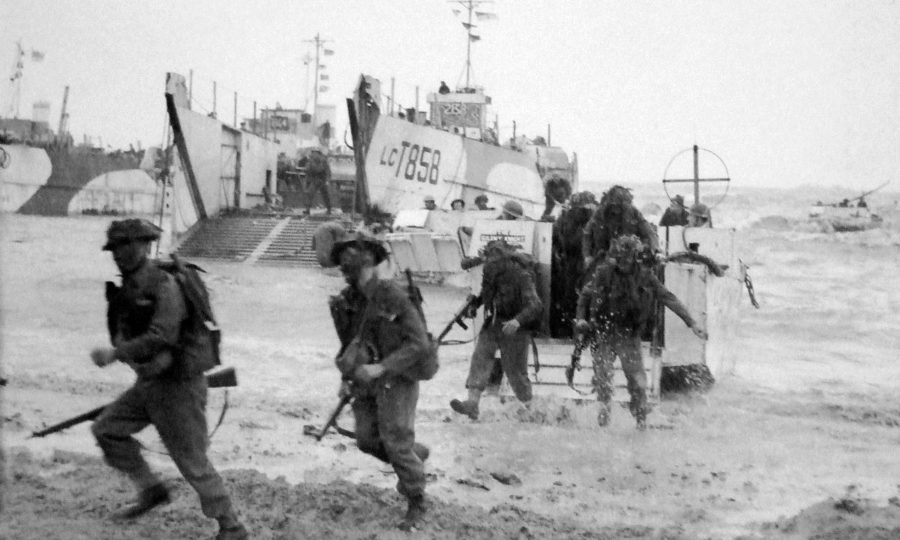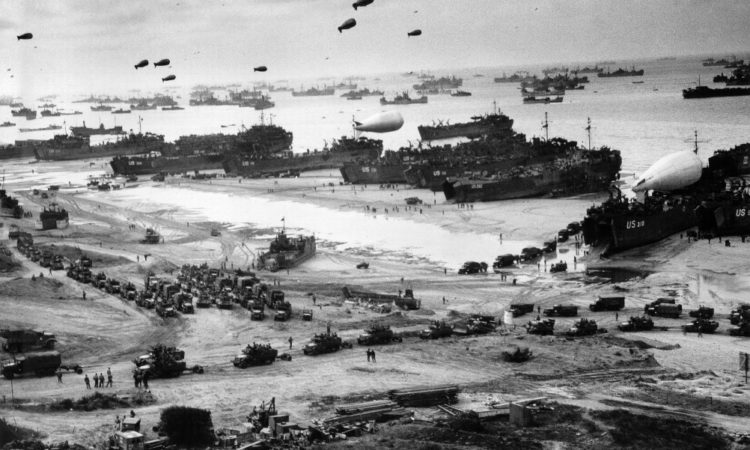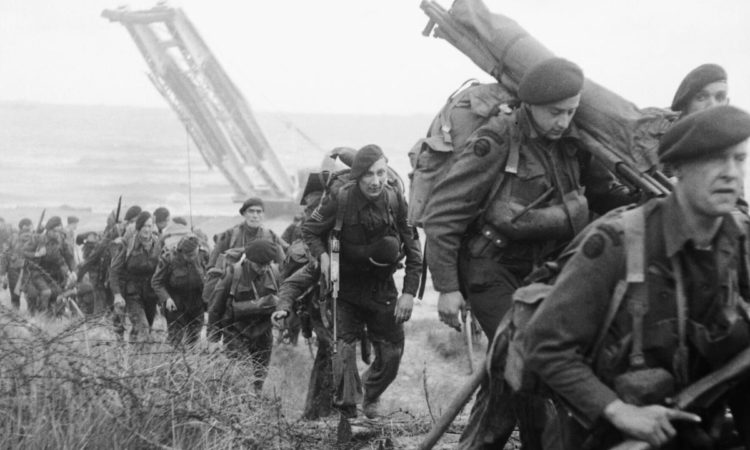D-Day (1944-2019)

Image: Royal Marine Commandos coming ashore on the Normandy coast, 6 June 1944 (Imperial War Museum B5246)
This year marks the 75th anniversary of the D-Day landings.
On 6 June 1944, also known as D-Day (D stands for Day), over 150,000 Allied troops landed on five of Normandy’s beaches during the second World War.
Operation Overlord was the name assigned to the establishment of a large-scale ‘lodgement’ on the Continent. The first phase, the amphibious invasion and establishment of a secure foothold, was codenamed Operation Neptune.
The landings were the largest seaborne invasion in history and have been called the beginning of the end of the war in Europe. It involved almost 5,000 landing and assault craft, 289 escort vessels and 277 minesweepers. Approximately 160,000 troops crossed the English Channel on D-Day, with 875,000 men disembarking by the end of June. However, there were over 10,000 Allied casualties, with 4,414 confirmed dead, on the first day. The Germans lost 1,000 men.

Panoramic view of the Omaha beachhead on the Normandy coast after it was secured, c.9 June 1944. (US National Archives Coast Guard Collection 26-G-2517)
Of those who died on the first day, with an association to Islington, was 27-year-old Islington resident Able Seamen Charles William Smith. Charles was serving on Landing Craft Infantry (LCI) vessel (S) 524 when, after landing commandos on Sword Beach, it was struck by a shell causing it to explode into flames. Sadly, nine men, including Charles Smith, from the craft lost their lives in the incident. He is Remembered with Honour at Chatham Naval Memorial.
Another Islington casualty on 6 June was Alfred Wyatt of Queen’s Head Street, N1. Alfred was a 24-year-old gunner in the Royal Artillery when he was killed in action. He is buried at Bayeux War Cemetery in Normandy. Also buried at Bayeux, having fallen on the same day, is Sapper William Heatley (19) of the Royal Engineers. William lived in Sutton Dwellings, Upper Street. Two further servicemen from Islington who lost their lives on 6 June 1944 were Serjeant Ernest Hounslow (24) of the Parachute Regiment and Royal Marine Edward Johnson (24).
The following day witnessed another five men, with Islington connections, fall during ‘Operation Neptune’. These were Rifleman Percy Godsave (28), Serjeant Richard Harris (24), Lance Corporal Ernest Schafer (30), Lance Corporal George Mitchell (24) and Trooper Walter Walters (20). The last two named were also laid to rest at Bayeux War Cemetery.
Operation Overlord lasted until 30 August 1944. Alongside those who died during the first D-Day landings, nearly 60 more Islington-connected casualties were recorded. Many of whom are buried in various cemeteries in Normandy.

Royal Marine Commandos move inland from Sword Beach on the Normandy coast, 6 June 1944. (Imperial War Museum B5071)
Meanwhile, many service personnel from Islington taking part in the two military operations did return to tell their stories about events in June 1944 and beyond. Following the Normandy landings, local newspapers published a number of borough-related articles. Here is some of what was written…
Glider record on D-Day, Islington Gazette 16 June 1944
‘Ex-Arsenal player beaten by 30 seconds’. One of the most disappointed men in the RAF is Squadron Leader Reginald Trim, who piloted one of the first RAF glider-towing aircraft into the Caen area in the early hours of D-Day. “It would be a bit of luck if I happened to be the first over,” he said, “I knew I was pretty early.” But the first schedules now show that Trim was beaten by 30 seconds, for the first glider-towing pilot was F/Lt Ronald Hobbs of Palmers Green.
Progress in Normandy, Islington Gazette, 20 June 1944
‘Islington Tribute to Allied Forces’. Presiding at Friday’s meeting of the Islington Borough Council, the mayor (Cllr A W Wynn) said he felt it to be an opportune moment for them to express their admiration and appreciation of the wonderful efforts of the Allied Forces in the major landings in Normandy…. The Mayor expressed the Council’s best wishes for a speedy and complete recovery of those who had been wounded, and voiced sincerest sympathy with the relatives and friends of those who had made the supreme sacrifice.
Holloway Paratrooper wounded, North London Press 23 June 1944
Paratrooper Jack Sidders (21) of Eden Grove returned from the landing beaches wounded but smiling. Taking part in the invasion was his first trip overseas! In the article he hoped to get well quickly so he could return to the fighting.
In 2015 Ken Watts (90), from Barnsbury, landed on the beaches of Normandy on D-Day after going to war aged just 19. He narrowly avoided serious injury weeks later when a mortar exploded two feet above his head. At age 90 he received the Légion d’honneur, France’s highest bravery medal, which is awarded to all D-Day veterans by application.
Ex-serviceman who took part in D-Day landings is among those paying tributes. Islington Tribune 13 November 2015
Islington Veteran’s Association member Ken Watts (90), from Barnsbury, landed on the beaches of Normandy on D-Day after going to war aged just 19. He narrowly avoided serious injury weeks later when a mortar exploded two feet above his head. At age 90 he also received the Légion d’honneur, France’s highest bravery medal, which is awarded to all D-Day veterans.
More Local History
- Barnsbury and Caledonian Road
- Archway and Tufnell Park
- Nag’s Head and Holloway
- Angel an Pentonville
- Bunhill and St Luke’s (Finsbury)
- Finsbury Park and Stroud Green
- Highbury
- Clerkenwell
- Islington Central and Canonbury
- Newington Green
- Victoria Cross memorial stones
- Streets with a story
- Islington during the First World War
- Islington and Holloway Fire Stations
- Society of Genealogists
- D-Day (1944-2019)
- Highbury Corner V-1 bomb
- Italians in Islington
- Islington on the Home Front during the Second World War
- Islington’s Pride: Our heritage, our future
- Islington as a Place of Refuge
- Barging Through Islington: 200 Years of the Regent’s Canal
- A short history of waste and recycling in Islington
- Gay Liberation Front at 50
